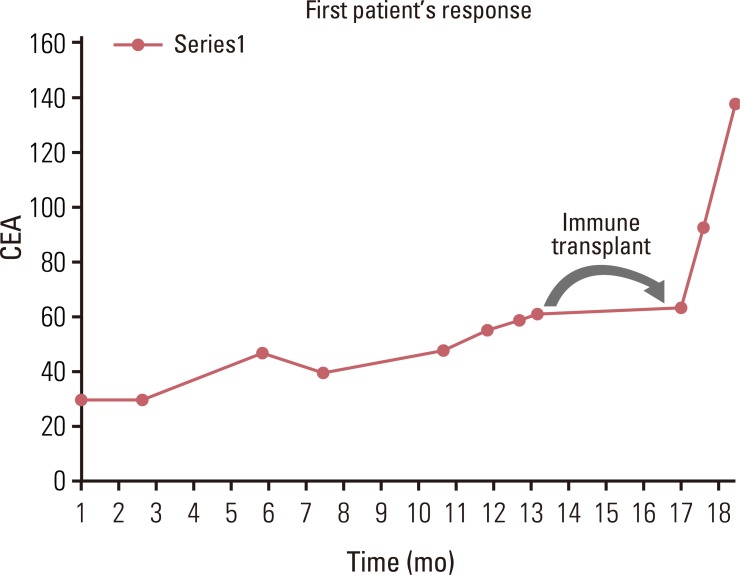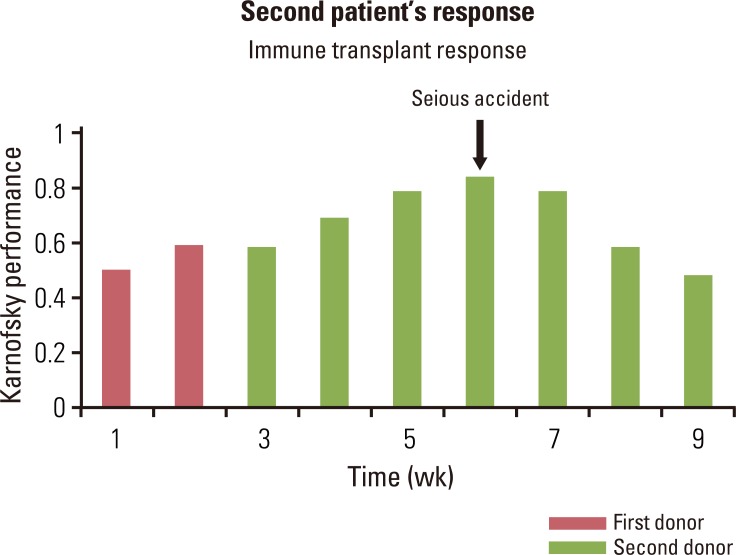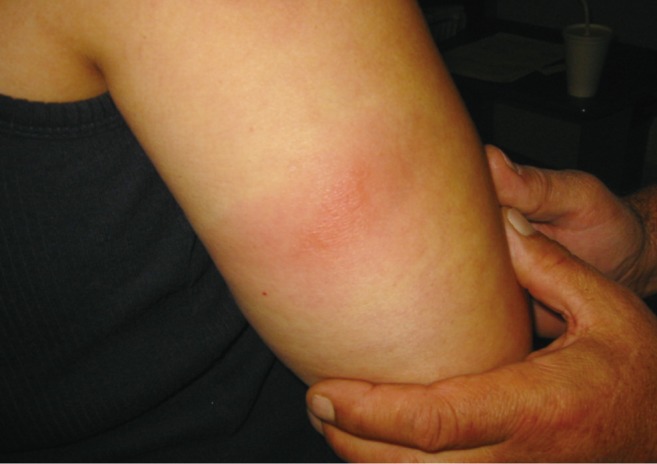Cancer Res Treat.
2012 Jun;44(2):133-141.
Irradiation of Donor Mononuclear Cells for Treatment of Chemorefractory Metastatic Solid Cancers: A Community-Based Immune Transplant Pilot Study
- Affiliations
-
- 1MedCenter One Health Systems, Department of Hematology & Oncology, Bismarck, ND, USA. jreyno@mohs.org
- 2Bismarck Cancer Center, Bismarck, ND, USA.
Abstract
- PURPOSE
Chemotherapy has demonstrated ability to generate tumor antigens secondary to induction of apoptosis, against which human leukocyte antigen-compatible, irradiated, related donor mononuclear cells may be administered with immune stimulation to activate antigen presenting and cytotoxic T cells, while minimizing risk of graft-versus-host disease (GVHD). The present study endeavours to describe feasibility and efficacy of this treatment, specifically in the community setting.
MATERIALS AND METHODS
Eligible patients had rapidly progressive, chemorefractory metastatic solid tumors. Treatment consisted of intravenous etoposide and cyclosporine for three days followed by granulocyte-macrophage colony-stimulating factor for 5 days. The following week, 5x10(7) haploidentical or more closely matched irradiated donor mononuclear cells were given weekly for 10 weeks along with interleukin-2.
RESULTS
Three patients were enrolled, and the regimen was well-tolerated, with no GVHD observed. All patients had clinical response, despite advanced and heavily pretreated disease.
CONCLUSION
The above-outlined protocol demonstrates favorable tolerability and efficacy, and appears to be feasible in the community setting. While the optimal chemotherapy, immunostimulation, and irradiation regimens may be further optimized, future investigation appears warranted, and may include community oncology programs.
MeSH Terms
-
Antigens, Neoplasm
Apoptosis
Cyclosporine
Etoposide
Graft vs Host Disease
Granulocyte-Macrophage Colony-Stimulating Factor
Humans
Immunization
Immunomodulation
Leukocytes
Leukocytes, Mononuclear
Neoplasm, Residual
Pilot Projects
T-Lymphocytes
Tissue Donors
Transplants
Antigens, Neoplasm
Cyclosporine
Etoposide
Granulocyte-Macrophage Colony-Stimulating Factor
Figure
Reference
-
1. Weynants P, Thonnard J, Marchand M, Delos M, Boon T, Coulie PG. Derivation of tumor-specific cytolytic T-cell clones from two lung cancer patients with long survival. Am J Respir Crit Care Med. 1999; 159:55–62. PMID: 9872818.
Article2. Karanikas V, Colau D, Baurain JF, Chiari R, Thonnard J, Gutierrez-Roelens I, et al. High frequency of cytolytic T lymphocytes directed against a tumor-specific mutated antigen detectable with HLA tetramers in the blood of a lung carcinoma patient with long survival. Cancer Res. 2001; 61:3718–3724. PMID: 11325844.3. Lehmann F, Marchand M, Hainaut P, Pouillart P, Sastre X, Ikeda H, et al. Differences in the antigens recognized by cytolytic T cells on two successive metastases of a melanoma patient are consistent with immune selection. Eur J Immunol. 1995; 25:340–347. PMID: 7875194.
Article4. Yamshchikov G, Thompson L, Ross WG, Galavotti H, Aquila W, Deacon D, et al. Analysis of a natural immune response against tumor antigens in a melanoma survivor: lessons applicable to clinical trial evaluations. Clin Cancer Res. 2001; 7(3 Suppl):909s–916s. PMID: 11300491.5. Rosenberg SA. Shedding light on immunotherapy for cancer. N Engl J Med. 2004; 350:1461–1463. PMID: 15070799.
Article6. Heriot AG, Marriott JB, Cookson S, Kumar D, Dalgleish AG. Reduction in cytokine production in colorectal cancer patients: association with stage and reversal by resection. Br J Cancer. 2000; 82:1009–1012. PMID: 10737381.
Article7. Gabrilovich DI, Kavanaugh D, Corak J, Nadaf-Rahrov S, Cunningham T, Carbone DP. Defective function of dendritic cells in patients with breast cancer can be overcome by generation of these cells from precursors, a new approach to cancer immunotherapy. Proc Am Soc Clin Oncol. 1996; 15:354.8. Blattman JN, Greenberg PD. Cancer immunotherapy: a treatment for the masses. Science. 2004; 305:200–205. PMID: 15247469.
Article9. Mapara MY, Sykes M. Tolerance and cancer: mechanisms of tumor evasion and strategies for breaking tolerance. J Clin Oncol. 2004; 22:1136–1151. PMID: 15020616.
Article10. Liyanage UK, Moore TT, Joo HG, Tanaka Y, Herrmann V, Doherty G, et al. Prevalence of regulatory T cells is increased in peripheral blood and tumor microenvironment of patients with pancreas or breast adenocarcinoma. J Immunol. 2002; 169:2756–2761. PMID: 12193750.
Article11. Dey BR, McAfee S, Colby C, Cieply K, Caron M, Saidman S, et al. Anti-tumour response despite loss of donor chimaerism in patients treated with non-myeloablative conditioning and allogeneic stem cell transplantation. Br J Haematol. 2005; 128:351–359. PMID: 15667537.
Article12. O'Donnell PV, Luznik L, Jones RJ, Vogelsang GB, Leffell MS, Phelps M, et al. Nonmyeloablative bone marrow transplantation from partially HLA-mismatched related donors using posttransplantation cyclophosphamide. Biol Blood Marrow Transplant. 2002; 8:377–386. PMID: 12171484.13. Waller EK, Boyer M. New strategies in allogeneic stem cell transplantation: immunotherapy using irradiated allogeneic T cells. Bone Marrow Transplant. 2000; 25(Suppl 2):S20–S24. PMID: 10933181.
Article14. Symons HJ, Levy MY, Wang J, Zhou X, Zhou G, Cohen SE, et al. The allogeneic effect revisited: exogenous help for endogenous, tumor-specific T cells. Biol Blood Marrow Transplant. 2008; 14:499–509. PMID: 18410892.
Article15. Vourka-Karussis U, Ackerstein A, Pugatsch T, Slavin S. Allogeneic cell-mediated immunotherapy for eradication of minimal residual disease: comparison of T-cell and IL-2 activated killer (LAK) cell-mediated adoptive immunotherapy in murine models. Exp Hematol. 1999; 27:461–469. PMID: 10089908.16. Morecki S, Yacovlev E, Gelfand Y, Vilensky A, Slavin S. Allogeneic versus syngeneic killer splenocytes as effector cells for the induction of graft-versus-tumor effect. Biol Blood Marrow Transplant. 2004; 10:40–48. PMID: 14752778.
Article17. Strair RK, Schaar D, Medina D, Todd MB, Aisner J, DiPaola RS, et al. Antineoplastic effects of partially HLA-matched irradiated blood mononuclear cells in patients with renal cell carcinoma. J Clin Oncol. 2003; 21:3785–3791. PMID: 14551297.
Article18. Correale P, Cusi MG, Tsang KY, Del Vecchio MT, Marsili S, Placa ML, et al. Chemoimmunotherapy of metastatic colorectal carcinoma with gemcitabine plus FOLFOX 4 followed by subcutaneous granulocyte macrophage colony-stimulating factor and interleukin-2 induces strong immunologic and antitumor activity in metastatic colon cancer patients. J Clin Oncol. 2005; 23:8950–8958. PMID: 16061910.
Article19. Slater LM, Sweet P, Stupecky M, Reynolds JT. Cyclosporin A/VP-16 produced immunity to L1210 leukemia: the participation of cytotoxic CD8 T-lymphocytes. Clin Immunol Immunopathol. 1995; 75:239–245. PMID: 7768041.
Article20. Stalder M, Bîrsan T, Hausen B, Borie DC, Morris RE. Immunosuppressive effects of surgery assessed by flow cytometry in nonhuman primates after nephrectomy. Transpl Int. 2005; 18:1158–1165. PMID: 16162103.
Article21. Rentenaar RJ, de Metz J, Bunders M, Wertheim-van Dillen PM, Gouma DJ, Romijn JA, et al. Interferon-gamma administration after abdominal surgery rescues antigen-specific helper T cell immune reactivity. Clin Exp Immunol. 2001; 125:401–408. PMID: 11531947.
Article22. Allendorf JD, Bessler M, Whelan RL, Trokel M, Laird DA, Terry MB, et al. Postoperative immune function varies inversely with the degree of surgical trauma in a murine model. Surg Endosc. 1997; 11:427–430. PMID: 9153168.
Article23. Létourneau S, Krieg C, Pantaleo G, Boyman O. IL-2- and CD25-dependent immunoregulatory mechanisms in the homeostasis of T-cell subsets. J Allergy Clin Immunol. 2009; 123:758–762. PMID: 19348914.
Article
- Full Text Links
- Actions
-
Cited
- CITED
-
- Close
- Share
- Similar articles
-
- Phase 1/2 donor antigen specific regulatory T cell-based cell therapy clinical trial to induce operational tolerance in living donor liver transplant patients
- Mycobacterial infections in solid organ transplant recipients
- A Pilot Study of Calcineurin Inhibitors (CNIs) and Steroid Avoidance Immunosuppressive Protocol among Living Donor Kidney Transplant Recipients
- Clinicopathological Study of 191 Cases of Metastatic Skin Cancers from Solid Cancer Diagnosed at the Department of Dermatology in a Tertiary Referral Cancer Center
- Allograft Immune Reaction of Kidney Transplantation Part 2. Immunosuppression and Methods to Assess Alloimmunity






